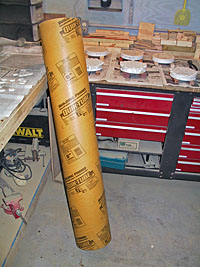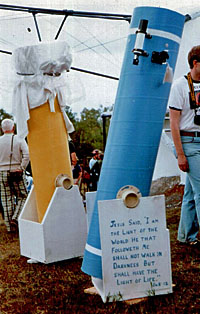

The Tube
The tube is an important element of your Newtonian telescope: It holds all the optical parts in alignment, it shields the optics from light and physical contact that might damage them. It is also the most visible part of your telescope, so many people want to make it look nice. In this section, we will describe the characteristics and options for your telescope tube. By now, you should know the required tube diameter and length.
Cardboard Concrete Form Tubes

As we have stated previously, we are going to use a concrete cardboard form tube as shown at right. This is the traditional Dobsonian tube. The are inexpensive, don't have to be built (just drill a few holes in them and trim to length), and they can be painted or decorated to look pretty good (more on this below).
They are available with wall thickness of 1/8 or ¼ inch, diameters of 6, 8, 10, 12, 14 inches and larger, and lengths of 4, 6, 8, 10 feet and longer. However, you may find that tubes longer than 6 feet and wall thicknesses of ¼ inch may not be available to you at normal retail outlets, and you may need to find a supplier to the trade to get these sized tubes.
You also need to be aware that these tubes are nominally sized: each nominally sized diameter is actually made in three or four diameters so that the tubes will nest for shipping and storage (See photo on prior page). So make sure you select one that meets your diameter requirement - a ½ inch variance of tube diameter is not important to the concrete industry, but it can be very important when you are making a telescope!
Tube Thickness
Thin (1/8 inch) tubes will be fine for 4, 6, and 8 inch mirrors. However, 10 and 12 inch mirrors weigh quite a bit, and the thinner tubes will not be able to support them properly, so you should use a ¼ inch thick tube for these size scopes. If you can't locate that thick a tube, you might consider buying two 1/8 tubes that nest, and cut a strip out of the larger one lengthwise so it can be firmly glued to the smaller one, effectively making a ¼ inch thick tube (be sure to use waterproof glue and cover all the contact area between the two tubes with glue).
Do Not Cut Your Tube Yet!

1980 Stellafane Convention
Even through we have a design for the scope, it would be wise to NOT cut your tube to length until the optics are installed and an image has been brought to focus. Then we will remove the optics, cut the tube to length if necessary, and paint the inside and outside of the tube before doing final assembly. You may find you have made an error in your design, or the stated focal length of the primary mirror was not accurately reported.
Of course, if your needed a 4 foot 3 inch tube and had to buy a 6 footer, you may want to cut it down to 5 foot as a working length and then reduce it to the final length after you test the optics. Just don't cut your options by cutting your telescope tube too soon!
Marking Circumferences on the Tube
When mounting components in the tube, or when it is time to cut your tube to length, you will need to mark a circumference around the tube. It is actually harder than it may seem to get a good mark that does not wander. Try this technique: wrap a sheet of newspaper around the tube, and line one edge of the paper up after it wraps tightly over itself. This edge of the paper is a good circumference, and you can make a mark along its edge.
Painting and Decorating
We will discuss painting and decorating your tube in more detail near the end of this project. For now, your need to know we will paint the inside of the tube a flat black, and the outside will be painted in a color you find attractive. You can also paint a picture on it, if you have the talent (see the scope in Anatomy of Dobsonian for an example of this). You can also cover the tube in fabric, glitter, wood veneer, plastic or other imaginative treatments.
Other Tube Options
Although we won't tell you how to do this in this article, you can build a wooden tube that is square, hexagonal, octagonal or approaches round with many small side. Or you could make a fiber glass tube, perhaps using the concrete form tube as a form. Plastic pipe tends not to be stuff enough, and is actually quite heavy. Aluminum tubing would be great if your can find something in the appropriate size (that is affordable!). Anyway, all sort of things have been used for telescope tubes, you can certainly be creative, and adapt our plans for something different if you are adventuresome.
Previous: The Primary Mirror Next:
The Primary Mirror Cell
Back to the Build a Dobsonian Master Index